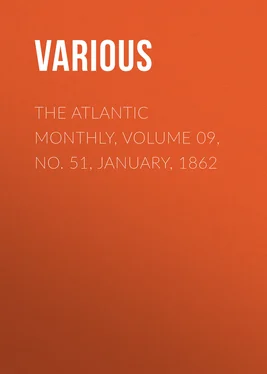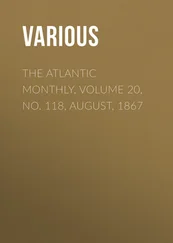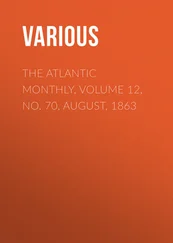Various - The Atlantic Monthly, Volume 09, No. 51, January, 1862
Здесь есть возможность читать онлайн «Various - The Atlantic Monthly, Volume 09, No. 51, January, 1862» — ознакомительный отрывок электронной книги совершенно бесплатно, а после прочтения отрывка купить полную версию. В некоторых случаях можно слушать аудио, скачать через торрент в формате fb2 и присутствует краткое содержание. Жанр: foreign_antique, periodic, foreign_edu, на английском языке. Описание произведения, (предисловие) а так же отзывы посетителей доступны на портале библиотеки ЛибКат.
- Название:The Atlantic Monthly, Volume 09, No. 51, January, 1862
- Автор:
- Жанр:
- Год:неизвестен
- ISBN:нет данных
- Рейтинг книги:4 / 5. Голосов: 1
-
Избранное:Добавить в избранное
- Отзывы:
-
Ваша оценка:
- 80
- 1
- 2
- 3
- 4
- 5
The Atlantic Monthly, Volume 09, No. 51, January, 1862: краткое содержание, описание и аннотация
Предлагаем к чтению аннотацию, описание, краткое содержание или предисловие (зависит от того, что написал сам автор книги «The Atlantic Monthly, Volume 09, No. 51, January, 1862»). Если вы не нашли необходимую информацию о книге — напишите в комментариях, мы постараемся отыскать её.
The Atlantic Monthly, Volume 09, No. 51, January, 1862 — читать онлайн ознакомительный отрывок
Ниже представлен текст книги, разбитый по страницам. Система сохранения места последней прочитанной страницы, позволяет с удобством читать онлайн бесплатно книгу «The Atlantic Monthly, Volume 09, No. 51, January, 1862», без необходимости каждый раз заново искать на чём Вы остановились. Поставьте закладку, и сможете в любой момент перейти на страницу, на которой закончили чтение.
Интервал:
Закладка:
But whatever its defects, the classification of Linnæus was the first attempt at grouping animals together according to certain common structural characters. His followers and pupils engaged at once in a scrutiny of the differences and similarities among animals, which soon led to a great increase in the number of classes: instead of six, there were presently nine, twelve, and more. But till Cuvier’s time there was no great principle of classification. Facts were accumulated and more or less systematized, but they were not yet arranged according to law; the principle was still wanting by which to generalize them and give meaning and vitality to the whole. It was Cuvier who found the key. He himself tells us how he first began, in his investigations upon the internal organization of animals, to use his dissections with reference to finding the true relations between animals, and how, ever after, his knowledge of anatomy assisted him in his classifications, and his classifications threw new light again on his anatomical investigations,—each science thus helping to fertilize the other. He was not one of those superficial observers who are in haste to announce every new fact that they chance to find, and his first paper 2 2 Sur un nouveau rapprochement à établir entre les Classes qui composent le Règne Animal. Ann. Mus. , Vol. XIX.
specially devoted to classification gave to the world the ripe fruit of years of study. This was followed by his great work, “Le Règne Animal.” He said that animals were united in their most comprehensive groups, not on special characters, but on different plans of structure ,—moulds, he called them, in which all animals had been cast. He tells us this in such admirable language that I must, to do justice to his thought, give it in his own words:—
“Si l’on considère le règne animal d’après les principes que nous venons de poser en se débarrassant des préjugés établis sur les divisions anciennement admises, en n’ayant égard qu’à l’organisation et à la nature des animaux, et non pas à leur grandeur, à leur utilité, au plus ou moins de connaissance que nous en avons, ni à toutes les autres circonstances accessoires, on trouvera qu’il existe quatre formes principales, quatre plans généraux, si l’on peut s’exprimer ainsi, d’après lesquels tous les animaux semblent avoir été modelés, et dont les divisions ultérieures, de quelque titre que les naturalistes les aient décorées, ne sont que des modifications assez légères, fondées sur le développement ou l’addition de quelques parties, qui ne changent rien à l’essence du plan.”
The value of this principle was soon tested by its application to facts already known, and it was found that animals whose affinities had been questionable before were now at once referred to their true relations with other animals by ascertaining whether they were built on one or another of these plans. Of such plans or structural conceptions Cuvier found in the whole animal kingdom only four, which he called Vertebrates , Mollusks , Articulates , and Radiates .
With this new principle as the basis of investigation, it was no longer enough for the naturalist to know a certain amount of features characteristic of a certain number of animals,—he must penetrate deep enough into their organization to find the secret of their internal structure. Till he can do this, he is like the traveller in a strange city, who looks on the exterior of edifices entirely new to him, but knows nothing of the plan of their internal architecture. To be able to read in the finished structure the plan on which the whole is built is now essential to every naturalist.
There have been many criticisms on this division of Cuvier’s, and many attempts to change it; but though some improvements have been made in the details of his classification, all departures from its great fundamental principle are errors, and do but lead us away from the recognition of the true affinities among animals.
Each of these plans may be stated in the most general terms. In the Vertebrates there is a vertebral column terminating in a prominent head; this column has an arch above and an arch below, forming a double internal cavity. The parts are symmetrically arranged on either side of the longitudinal axis of the body. In the Mollusks , also, the parts are arranged according to a bilateral symmetry on either side of the body, but the body has but one cavity, and is a soft, concentrated mass, without a distinct individualization of parts. In the Articulates there is but one cavity, and the parts are here again arranged on either side of the longitudinal axis, but in these animals the whole body is divided from end to end into transverse rings or joints movable upon each other. In the Radiates we lose sight of the bilateral symmetry so prevalent in the other three, except as a very subordinate element of structure; the plan of this lowest type is an organic sphere, in which all parts bear definite relations to a vertical axis.
It is not upon any special features, then, that these largest divisions of the animal kingdom are based, but simply upon the general structural idea. Striking as this statement was, it was coldly received at first by contemporary naturalists: they could hardly grasp Cuvier’s wide generalizations, and perhaps there was also some jealousy of the grandeur of his views. Whatever the cause, his principle of classification was not fully appreciated; but it opened a new road for study, and gave us the keynote to the natural affinities among animals. Lamarck, his contemporary, not recognizing the truth of this principle, distributed the animal kingdom into two great divisions, which he calls Vertebrates and Invertebrates . Ehrenberg also, at a later period, announced another division under two heads,—those with a continuous solid nervous centre, and those with merely scattered nervous swellings. 3 3 For more details upon the different systems of Zoölogy, see Agassiz's Essay on Classification in his Contributions to the Natural History of the United States , Vol. I.
But there was no real progress in either of these latter classifications, so far as the primary divisions are concerned; for they correspond to the old division of Aristotle, under the head of animals with or without blood, the Enaima and Anaima . This coincidence between systems based on different foundations may teach us that every structural combination includes certain inherent necessities which will bring animals together on whatever set of features we try to classify them; so that the division of Aristotle, founded on the circulating fluids, or that of Lamarck, on the absence or presence of a backbone, or that of Ehrenberg, on the differences of the nervous system, cover the same ground. Lamarck attempted also to use the faculties of animals as a groundwork for division among them. But our knowledge of the psychology of animals is still too imperfect to justify any such use of it. His divisions into Apathetic, Sensitive, and Intelligent animals are entirely theoretical. He places, for instance, Fishes and Reptiles among the Intelligent animals, as distinguished from Crustacea and Insects, which he refers to the second division. But one would be puzzled to say how the former manifest more intelligence than the latter, or why the latter should be placed among the Sensitive animals. Again, some of the animals that he calls Apathetic have been proved by later investigators to show an affection and care for their young, seemingly quite inconsistent with the epithet he has applied to them. In fact, we know so little of the faculties of animals that any classification based upon our present information about them must be very imperfect.
Читать дальшеИнтервал:
Закладка:
Похожие книги на «The Atlantic Monthly, Volume 09, No. 51, January, 1862»
Представляем Вашему вниманию похожие книги на «The Atlantic Monthly, Volume 09, No. 51, January, 1862» списком для выбора. Мы отобрали схожую по названию и смыслу литературу в надежде предоставить читателям больше вариантов отыскать новые, интересные, ещё непрочитанные произведения.
Обсуждение, отзывы о книге «The Atlantic Monthly, Volume 09, No. 51, January, 1862» и просто собственные мнения читателей. Оставьте ваши комментарии, напишите, что Вы думаете о произведении, его смысле или главных героях. Укажите что конкретно понравилось, а что нет, и почему Вы так считаете.












